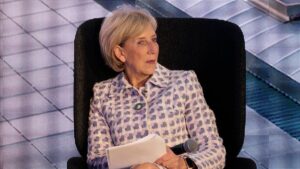Ground Breakers: Goldman says it would cost US$25 billion for the West to recreate China’s rare earths market

Pic: Andrii Lysenko/iStock via Getty Images
- Goldman Sachs knocks down rare earths price forecasts on Chinese supply rush
- But it says demand will be strong from EVs and wind turbines, with demand to outpace supply from 2028
- Lithium players surge on Patriot, Rio news
Goldman Sachs has put a high price on the development of a rare earths industry in the West that could challenge the dominance of China, while also knocking price forecasts down a peg.
But analysts Paul Young and Caleb Heiner also say efforts from companies like Tesla to switch and reduce the intensity of rare earths magnets out in their EVs will have a limited impact on the market, amounting to just 1% of NdPr demand by 2030.
All in all it could cost upwards of US$25 billion to replace the 50,000t produced in China — itself a doubling of production in the past two years — largely from iron ore tailings by China Northern Rare Earths in Inner Mongolia and displace it with Western supply.
“With China producing >70% of the world’s NdPr, Western governments are trying to fund new ex-China producers into the market,” GS’ Young and Heiner said.
“Based on capex benchmarking for the 6 RE processing/value-add steps, we believe that if the West wanted to replicate the 50ktpa of Chinese NdPr production to create an ex-China market, this could cost US$15-30bn, based on greenfield and brownfield project capex benchmarking of >20 projects ex-China project capital estimates which indicates a range of US$1-2bn of capex for the mine to refinery development of 4ktpa NdPr oxide and a further ~US$250-500mn for metal and magnet processing capacity.”
There are around 20 projects outside of China that could produce over 100,000t a year of rare earths and around 20,000tpa of neodymium and praseodymium, the two light rare earths metals key to permanent magnets.
But not all will get up.
“The market still requires strong growth in ex-China supply to meet growing demand post 2025,” Young and Heiner say.
“One of the major challenges for new RE mining entrants is the refining, metal and magnet bottlenecks outside of China, along with lack of equity market funding for smaller companies, and challenges with permitting and off-take.
“We continue to assess over 20 ex-China RE projects that have the potential to produce over 100ktpa of REOs and ~20ktpa of NdPr and believe that only 2-3 of these projects can get off the ground this decade due to the aforementioned barriers.
“This is despite significant funding from Western governments to develop an ex-China supply chain.”
China keeps the market in balance
China’s rare earths production quotas were up 20% year on year in the first half of 2023, something Goldman believes has pushed a market previously expected to be in deficit until 2025 into balance.
By 2026 ex-China supply will also increase with Australia’s Lynas (ASX:LYC) doubling the NdPr capacity of its Mt Weld mine and associated Australian and Malaysian processing plants to 12,000tpa while Iluka Resources (ASX:ILU) will be operational at its 4,000tpa, $1.2 billion Eneabba Refinery near Geraldton on WA’s Mid West coast.
With new market balance forecasts, Young and Heiner say they are knocking down their NdPr price forecasts from US$90, US$95 and US$95/kg for the next three years to US$80, US$85 and US$90/kg between 2024 and 2026.
“While we think CNRE will prevent the market from moving into a large surplus, we believe that the marginal cost for NdPr is well below US$50/kg when assuming all other REs are treated as cost credits, and the market has very little cost support at current price levels,” they say.
“Our view of long run deficits and ex-China refining, metal and magnet bottlenecks underpins our unchanged long run NdPr price of ~US$80/kg (real $, from 2027), which we believe is the minimum price required to incentivise new refinery developments and expansions based on our economic assessments of the higher quality global rare earth deposits.”
NdPr pricing has fallen sharply in 2023 from US$124/kg average across 2022 to US$69/kg on average in the June quarter.
But demand will continue to grow
While the picture to the middle of the decade now looks like one in balance, Goldman remains bullish on the outlook for demand growth from the EV and wind turbine sectors to 2030.
NdPr demand is expected to rise at a compound annual growth rate of 7% to 2030, with EV and wind applications lifting from a quarter to a half of the bank’s 110,000tpa 2030 consumption estimate.
It could be later in the decade before demand really starts to outpace supply though, with Young and Heiner seeing that inflection point emerging in 2028.
In the near term they say China will left EV sales by 2m units or around 30% this year, though four major Chinese magnet manufacturers — Zhongke Sanhuan, ZH Mag, JL Mag and Ningbo Heli Mag — are all expected to grow their NdFeB capacity by over 10% in the coming two years.
As for fears Elon Musk could engineer permanent magnets out of EV motors?
“The lack of ex-China RE supply has forced global auto OEMs such as BMW and Telsa to look into reducing NdPr intensity in EV drivetrain magnets. We think attempts to replace NdPr in the next few years would impact only ~1% of NdPr demand on our numbers by 2030,” Young and Heiner reckon.
Goldman has a Buy rating on Iluka, owing to strong mineral sands pricing and Neutral rating on Lynas.
Rare earth companies share prices today:
Patriot storms back as Rio enters Canadian lithium fray
Patriot Battery Metals (ASX:PMT) shares surged in Canada overnight as the company responded to a short-seller’s report and speculation its chairman Ken Brinsden’s old company Pilbara Minerals (ASX:PLS) was hunting a deal.
Its performance in the Australian market was more muted but still up a tidy 3-odd %.
The response to the short report and the post-fightback bump is pretty run of the mill stuff when this sort of thing happens.
End of the day, the eventual outcome will depend on how the Corvette lithium resource due this month shakes out.
As for the ‘inbound interest’?
“Whilst Patriot has received strong inbound interest in relation to Corvette from a range of tier 1 global mining and chemicals companies, the company can confirm that it has not received any takeover or corporate proposals to date,” PMT said.
“Patriot has appointed a range of advisers and key personnel to support the continued development and financing of Corvette, as an independent lithium company.
“Consequently, management’s focus is on advancing a maiden resource, accelerating exploration drilling, progressing permitting and advancing environmental and study work, whilst considering its funding options in parallel.”
That’s the sort of response that could be taken any which way.
There were some final assay results from the pre-resource winter drill program at the Corvette program over in Quebec’s Aussie enclave at James Bay as well.
They included 108m at 2.44% Li2O (195.5m to 303.5m), including 37.5m at 3.58% Li2O or 16.0m at 4.08% Li2O in hole CV23-181, and 115.3m at 1.81% Li2O (175.0m to 290.3m), including 89.6m at 2.20% Li2O in hole CV23-177.
How that all fits together with previous drill hits will be seen in that resource estimate, which CEO Blair Way remains, understandably, bullish on.
“We are very pleased to have received the last batch of assay results from the winter drill program which means our imminent release of the resource remains on track,” he said.
“I am confident that the upcoming maiden resource will demonstrate the significance of the Corvette discovery to the evolving North American and European lithium raw materials markets.”
They have an interesting new neighbour as well, with Rio Tinto (ASX:RIO), the only super-duper mega cap miner jumping head-first into lithium, signing a farm-in deal to explore the Corvet and Kaanaayaa projects for Canada’s Azimut Exploration just a few klicks from Patriot.
Rio has already committed to spend C$1.5m on each property over the next year once Canada’s wildfire season has died down, with C$14m of exploration expenditure and some cash payments worth C$1.7m to earn it a 50% stake.
Another C$100m of exploration expenditure after that could bring Rio’s stake to 70%, a level of investment that will probably only occur if the early stuff looks promising. Rio’s emergence in the district may well bring some competition for smaller big fish like PLS and MinRes (ASX:MIN) looking closely at that Patriot resource.
It follows a similar deal Rio made to option into claims in the James Bay lithium district held by Midland Exploration in June.
Rio, meanwhile, is about to start a 1400m RC drilling campaign at its earn-in with Everest Metals Corporation (ASX:EMC) at its North Rover lithium project in WA, news which has the minnow up a handy 17 or so %.
All this has the lithium sector very, very hot today.
Pretty much all the majors are green, with new market darling and Pilbara explorer Azure Minerals (ASX:AZS) up 10%.
It’s got an investor presentation out today, stating a resource estimate is being targeted for the first quarter of 2024 at its Andover lithium JV with Mark Creasy, with a 100,000m RC and diamond drilling program planned this year.
The company’s biggest shareholder is Chile’s SQM, one of the world’s largest lithium producers.
Lithium miners share prices today:
Capricorn Metals hits guidance
The materials sector is up 1.33% this morning, with gold miners joining lithium stocks on a bullish run today.
Bellevue Gold (ASX:BGL) was up over 10% in a largely unexplained spike, while Mark Clark’s Capricorn Metals (ASX:CMM) surged 5% and then some after hitting guidance.
28,859oz from its Karlawinda mine in the June quarter took CMM’s total for FY23 to 120,014oz, within its 115,000-125,000oz range for the year.
The partial close out of its hedge book is also a positive, meaning it will be able to take spot gold prices for the next 12 months.
CMM finished the quarter with $110.3m in the bank after building $27.6m of cash, cancelled out by a $36.8m payment to close part of its hedging arrangements early.
Capricorn Metals (ASX:CMM) and Bellevue Gold (ASX:BGL) share prices today:
At Stockhead, we tell it like it is. While Azure Minerals is a Stockhead advertiser, it did not sponsor this article.
Related Topics

UNLOCK INSIGHTS
Discover the untold stories of emerging ASX stocks.
Daily news and expert analysis, it's free to subscribe.
By proceeding, you confirm you understand that we handle personal information in accordance with our Privacy Policy.








